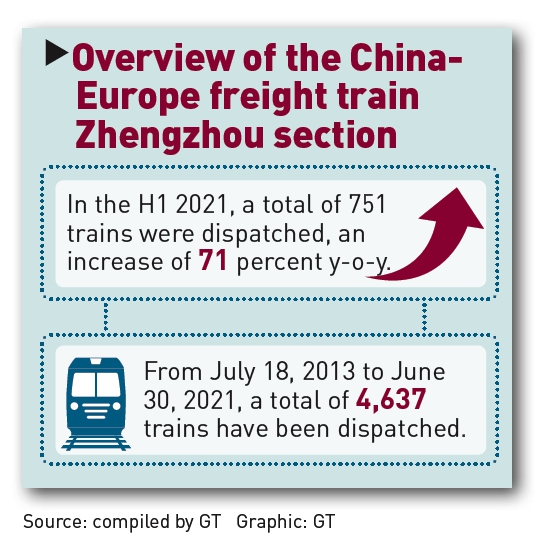
A China-Europe freight train (Zhengzhou) Photo: cnsphoto
Disrupted freight between Zhengzhou, the capital city of Central China's Henan Province, and Europe is gradually resuming, following unprecedented flooding and a week-long stretch of emergency controls.
According to a post from the Zhengzhou government on Sunday, the Zhengzhou section of the China-Europe freight train has officially resumed operation on Sunday, after rail freight operations between Zhengzhou and Europe was suspended on July 20 due to severe flooding.
At 11:30 am Sunday morning, the China-Europe freight train (Zhengzhou) departing from Liege, Belgium arrived at the Zhengzhou Railway Port, marking the resumption of normal operations of the China-Europe Express (Zhengzhou), according to Zhengzhou authority.
The train departed from Zhengzhou Railway Port at 6 pm Sunday afternoon.
The resumption came as the heaviest rainfall in 60 years in Zhengzhou attracted worldwide attention and disrupted transportation across the province.
As of Monday, the heavy rainfall in Henan since July 16 has left 69 people dead and 5 missing.
More than 1.47 million people were relocated and more than an area of 972,000 hectares of corps were affected, and 13,943 houses were collapsed, according to local authority.
Multiple rail routes and highways through the province have been cut off due to extreme weather, while a large number of flights were canceled.
Rescue and relocation work remain ongoing, though rail operations are gradually restoring in the city, which serves as a key transport hub in China and is one of the five major consolidation centers for China-Europe trains.
Zhengzhou is an important hub for cross-border freight trains.
To strengthen its connection with European countries, the city has built an inland port to handle the China-Europe freight trains. Zhengzhou's comprehensive operation capability also ranks among the forefront of cities that run the China-Europe freight trains in the country.
In the first half of 2021, there were a total of 751 trains from Zhengzhou to Europe, a year-on-year increase of 71 percent. Since the launch of the first China-Europe train on July 18, 2013, Zhengzhou has sent 4,707 trains to the countries along the Asia-Europe route, according to a report from China Central Television on July 18.

Graphic: GT
Possible delays in Christmas itemsNevertheless, despite the official resumption for China-Europe rail on Sunday, industry observers told the Global Times on Sunday that impact could still linger for a while and cause delays given that inter-city transport is still not fully resumed yet.
An employee surnamed Wang from Bondex Logistics said that the China-Euro Railway Zhengzhou part has resumed operation. However due to the torrential rain that deluged road traffic, urban sections leading to the railway station are impassable.
"The delay is expected to be about half a month," Wang told the Global Times on Sunday.
Moreover, industry insiders also cautioned that the disruption also arrived as many exporters have already started shipping Christmas products, with the rail link considered as an ideal transport route to avoid delays when ocean shipment getting more expensive and inaccessible.
An employee surnamed Zhu from China-Euro Railway International Logistics said the company's warehouse was overstocked with delayed goods and new goods keep arriving.
"At present, the damage of containers and goods has not been inspected," Zhu told the Global Times on Sunday, adding that goods sent from Zhengzhou include a spectrum of items and goods, such as lamps and cutting machines, that are mainly departing for Poland, Germany, Belgium and Italy.
Due to the low efficiency of sea-bound shipping, Zhu said his company has seen mounting orders with China-Europe railway this summer, almost doubling year-on-year.
"In July, the railway has arranged more trains running on China-Europe railway. We have received orders that are set to deliver in August since last week," Zhu said.
The China-Europe freight-train service has recorded more than 40,000 trips, with the transported goods valued at over $200 billion.
Since the first China-Europe freight train left Southwest China's Chongqing Municipality in March 2011, the service has reached more than 160 cities in 22 European countries, according to a report from the Xinhua News Agency in June.
The intercontinental rail route is considered a significant part of the Belt and Road Initiative (BRI) to boost trade between China and countries participating in the initiative. It's also a silver lining amid a devastating pandemic, which has boosted fragile supply chains across Eurasian countries, saving businesses in both China and Europe.
Vast quantities of anti-pandemic supplies were sent through the route, with special trains carrying surgical masks, medical gloves, water-soluble bags, contactless gel dispensers and other supplies to countries along the BRI route.





